Curry Supply Offers Keystone Service Bodies to Fit Contractors’ Sweet Spot

Curry Supply is introducing a new line of service truck bodies: Keystone and Keystone Pro. The Pro version features a crane body, and both models are built using light-weight, high-strength aluminum.
The crane tower on the Keystone Pro can handle up to a 25,000-foot-pound crane, while still providing compartment space for tool and equipment storage. Custom features and upgrades will be available on both Keystone builds, with work-ready stock trucks ready to ship nationwide beginning in the fourth quarter of 2021. Options include tool drawers and bolt bins, e-track, lube equipment, welder/generators, air compressors and multiple crane models.
Keystone bodies feature a 52-inch-wide and 129-inch-deep bed, with tie-down rings and a textured, slip-resistant floor for added safety. Each side features four compartments, three vertical and one horizontal, with at least 20 inches of depth and adjustable shelving. Protected door seals and stainless-steel rotary latches ensure compartments stay secure and watertight.
“Curry Supply’s introduction of the Keystone line of service bodies will fill a void in the mobile service truck market that we have experienced for quite some time,” says Jeff Shaw, company vice president of sales and marketing.
“Service trucks typically fall on the polar ends of both price and durability. You either have a robust, heavy-duty offering with tons of added content, or a light-duty offering that struggles to keep up in severe-duty environments and doesn’t accept application-specific modifications well. To find the middle ground, buyers are typically left to add light-duty options to an over-built body, or “heavier” options to a body that wasn’t designed to handle it.”
The objective at Keystone was to design a product optimized to hold up well in severe-duty environments and accept application-specific modifications at a lower price than most heavy-duty products, says Shaw. This resulted in features such as reinforced side packs with mounting rails to handle heavier accessories, robust doors, hinges, and weatherproofing.
“All of these address the common complaints contractors voice about light-duty service bodies,” says Shaw. “We reduced content by making crane reinforcement optional, and even still, we only engineered the reinforcements to some of the lighter duty electric/hydraulic cranes common to the applications this product was intended.”
The Keystone and Keystone Pro will be positioned alongside Curry Supply’s current offerings of Stellar, Autocrane, Reading, and Wilcox bodies.
Did you miss our previous article…
https://www.tortowheaton.com/?p=539
Nimble & Productive: Bobcat’s New L65 and L85 Compact Wheel Loaders
Compact wheel loaders continue to grow in popularity as contractors discover their many attributes: how they can dump higher, travel faster and turn tighter than skid steers and compact track loaders. And did we mention they do all this with a smaller engine and great fuel economy?
Bobcat’s latest entries into the compact wheel loader field include the L65 and L85 with standard bucket capacities of up to 1 cubic yard and a Z-bar front linkage. In addition to buckets and pallet forks, the new loaders hook up to a wide range of Bobcat tools and attachments using the powered Bob-Tach system.
The new loaders run on a redesigned Tier 4 Final Bobcat engine with improved cold-weather starting capability and components simplified for routine maintenance. The 2.4-liter turbocharged diesel engines put out 55 and 68 horsepower on the L65 and L85, respectively. The attachment control mode enables you to vary the engine and travel speeds separately to optimize auxiliary hydraulic performance.

Bobcat L85 compact wheel loaderDoosan BobcatA large fuel filter protects the engine from contamination and results in a longer filter life and increased holding capacity. The lift pump and self-priming fuel system offers continuous forced air outflow and eliminates the need for a primer bulb. And a pre-filter protects the lift pump from debris and particles that increase wear and degrade performance.
Articulated steering on the new L65 and L85 loaders delivers high maneuverability and a tight turning radius. The electronic hydrostatic transmission (E-HST) makes quick forward-reverse direction changes efficiently, increasing acceleration and delivering seamless speed control. The combination of the E-HST transmission and horsepower management automatically adjusts the loaders’ drive system to maximize pushing and loading power while minimizing the chance of stalling. Unlike other anti-stall systems, operators can maximize engine and drive torque on the L65 and L85 to match the demands of heavy lifting and digging.
Standard features include two-speed travel, differential lock, inching pedal, LED work lights, bucket level indicator and a 5-inch display with jog shuttle. Upgrade options include an attachment control device (seven pin connector), automatic ride control, enclosed cab with HVAC, rearview camera and a cloth suspension seat.
Quick Specs
Bobcat L65>
• Rated Operating Capacity with Bucket (Straight) 3,133 lb.
• Rated Operating Capacity with Bucket (Articulated) 2,618 lb.
• Rated Operating Capacity with Forks (Straight) 3,759 lb.
• Rated Operating Capacity with Forks (Articulated) 3,172 lb.
• Operating Weight 9,944 lb.
• Auxiliary Std Flow 19.8 gpm
Bobcat L85 >
• Rated Operating Capacity with Bucket (Straight) 3,974 lb.
• Rated Operating Capacity with Bucket (Articulated) 3,257 lb.
• Rated Operating Capacity with Forks (Straight) 4,786 lb.
• Rated Operating Capacity with Forks (Articulated) 3,977 lb.
• Operating Weight 11,164 lb.
• Auxiliary High Flow 27.34 gpm
Industry Roundup: Yanmar, ASV Add Four Dealers
Yanmar Compact Equipment and its company ASV Holdings have added four new dealers and a total of 15 new locations to its network.
Incoming dealers include Mid Country Machinery, Syracuse, New York; Woodco Machinery, Woburn, Massachusetts; Alta Equipment, Livonia, Michigan; and Quality Equipment and Parts, based in Lake City, Florida.
Woodco will cover the two product lines in three Massachusetts locations as well as one branch in Rhode Island. Alta adds the lines in three Michigan and three Florida locations. In addition, existing dealer Romco Equipment has has added three new locations in Texas.
The dealers will carry Yanmar’s compact excavators, tracked carriers and wheel loaders, and ASV’s compact track loaders and skid steers.
MANUFACTURERS, SUPPLIERS
Randall-Reilly names Manthey CTO

MantheyRandall-Reilly has named Keith Manthey as its CTO, charged with helping the technology and analytics company continue its growth and innovation trajectory. Matheny comes to Randall-Reilly most recently from Dell Technologies, where he served as a global CTO and as one of their artificial intelligence and analytics leaders, and Equifax, where he led their Data Platforms Group building their data factory systems.
“In our search for the right candidate to fill this role, we focused on finding a ‘growth CTO,’ someone who would help us continue to infuse leading edge analytics and value-added features into our product platforms,” says Randall-Reilly CEO Matt Reilly. “In addition, we were looking for someone with deep experience collaborating across divisions and with clients and who has experiences as a leader in companies in growth mode. Keith delivers on all fronts.”
Manthey will work with the Randall-Reilly team to build consumer-grade user interfaces and leverage analytics to provide new insights into trends, pricing, or useful industry patterns.
CNH temporarily closes several European plants
Production has temporarily been suspended at several of CNH Industrial’s European agricultural, commercial vehicle and powertrain manufacturing facilities.
The owner of Case and New Holland Construction Equipment says it’s facing ongoing disruptions to the procurement environment and shortages of core components, especially semiconductors.
CNH plans to resume production within eight working days.
Vacuworx names Cunningham VP of sales
Vacuworx has promoted Charlie Cunningham to vice president of sales. He formerly served as senior director of sales for the North America region.
Cunningham will be responsible for managing U.S. dealer sales and development. He will report to Bill Soloman, president of Vacuworx. Cunningham joined Vacuworx in January 2020 and has more than two decades of industry experience in sales management, product training and business development.
Vacuworx’s products include vacuum lifting and material handling equipment for the oil and gas pipeline and construction segments.
Big bucket and counterweight enable Komatsu’s new WA480-8 to fill trucks in just three passes

Engineered as a three-pass match loader for aggregates and other materials, the new Komatsu WA480-8 yard loader can also be used in infrastructure, forestry and non-residential applications where you need to move a lot of material efficiently.
Komatsu added a 1,400-pound counterweight to this version of the WA480-8 to help you fill the generously sized 7.2 cubic yard bucket while also enhancing stability. Low-profile tires add stability while helping to transfer the machine’s 299 horsepower to the ground. For trailering and transportation considerations the WA480-8 weighs between 57,232 and 61,311 pounds.
The shape of the bucket, with a long jaw and decreased strike plane angle, provides smooth material flow and lower resistance while the curved side edges minimize spills. All together these improvements make the WA480-8 suitable for high volume truck loading, carrying, stockpiling and hopper charging applications.
To maximize brake life in long load-and-carry or high-speed operations, the new loader supplements wet-cooled brakes with an air-cooled brake system that has demonstrated cooling improvements of 56-to 58-degrees Fahrenheit. This reduces the risk of overheating the brakes in severe conditions. A sensor on the electric drive pump measures axle temperature and activates the system when needed. A lock-up torque converter improves driveline efficiency and fuel economy during those long hauls.
In the Level 2 ROPS/FOPS cab, the loader offers an optional Komatsu Advanced Joystick Steering System and a heated air suspension seat. The pressurized cab keeps dust on the outside and makes for a more comfortable operating environment.
An auto-shift transmission with a mode selection feature and an automatic digging system with a boom kick out help the operator focus on the work rather than the machine. The hydraulic-drive fan has auto reverse to keep the radiators and cooling system clean and efficient. Large gull-wing type engine doors and large steps on both sides of the frame make engine access easier. Auto-idle shutdown and Komatsu’s Smart Loader Logic help conserve fuel.
Did you miss our previous article…
https://www.tortowheaton.com/?p=527
The Future of Paving? Volvo Unveils Its CX01 Concept Compactor
Asphalt compactors aren’t known as the most difficult machine to operate on the job. Although compactors perform a critical function especially when smoothness specs are at stake, many contractors put their less-seasoned operators on them.
But what if these machines didn’t even require an on-board operator?
Enter Volvo Construction Equipment’s CX01 asphalt compaction concept, a planned ConExpo reveal that had to wait until the recent Utility Expo to get in front of contractors.
“We just wanted to examine what the future of compaction would look like,” Justin Zupanc, head of Volvo CE’s asphalt compaction development team, told Equipment World at the show. “We wanted to create a better operator’s environment, reduce fuel consumption and exhaust emissions and boost productivity.”
“Better operator environment” translates to no cab. Instead, a connected fleet of CX01 single-drum units directed by a downloaded compaction plan would be either be remotely controlled by an operator or controlled autonomously.
Volvo already has an autonomous system on its TA15 haulers, now in customer testing, and the plan is to test a similar system on the CX01, Zupanc says.
The CX01 does not have an articulation joint “so there’s no balance point, there’s nothing that we can steer away from,” Zupanc says. Volvo solved this by using a split-drum which has two halves that can be operated independently kept upright by using a self-balancing control system. (The split drum comes off of its current 9-ton class machine sold in Europe.) To turn, operators can vary the rate of speed of each half of the drum. “You can make a fairly tight turn,” he says.
And while it wouldn’t be used while the unit is on asphalt, users also would have the ability to pivot steer the machine.
Rethink the paving process

The Volvo CX01 prototype compactor features guarding and emergency stops on each corner.Equipment World
Volvo says the CX01 which stands for compaction experimental unit No. 1 provides the means to “fundamentally rethink the paving process.” By removing the operator, you’re also removing their exposure to vibration, noise and dust.
As envisioned, a fleet of CX01s could be deployed on larger jobs and communicate not only with each other but with other machines on site. The machines could survey the job, report on mat conditions such as density, temperature and passes (which intelligent compactors are already doing) and determine when and where to compact. “They can shift over if an area is already compacted,” Zupanc says. “All information is available to the crew and to other machines. You could even send it to the asphalt plant.”
The machine’s compact design and maneuverability could also lead to streamlined compaction cycles, reduced costs and more agile work patterns, Volvo says. The rolling pattern, weight and number of rollers could be adjusted to match the width, thickness and speed of the paving operation. Using Volvo’s existing Co-Pilot system, operators can use a touchscreen to remotely control the compactors.
Flexible power
The CX01 has a flexible power system. It has both a 1.7-liter diesel engine and an energy storage system that can be operated indiesel-only, hybrid or fully electric modes. “The diesel is only there to spin the 20-kilowatt generator,” Zupanc says. The generator in turn powers two 48-volt ultracapacitors placed on each side of the drum, which in turn are powering three 14-kilowatt electric motors, one for each side of the drum, and another to power the vibration system eccentrics.
“You can run it with the diesel engine on, and it’s always charging the ultracapacitors,” Zupanc says. When the ultracapacitors are charged, the engine can be turned off, and the machine becomes fully electric. The engine will cycle back on when the ultracapacitor charges get low. “They charge very quickly, within a couple of minutes,” he says. The downside: the capacitors don’t have the capacity of a lithium-ion battery; runtime is around 20 minutes, depending on your speed.
“We had never used them before, and we wanted to see how they worked,” Zupanc says, explaining why Volvo was using ultracapacitors on the CX01. “While they don’t have the capacity of lithium-ion batteries, they are good for vibration and they have a long lifecycle. They may not be the right solution because they don’t have that longevity, and who knows, we may couple them with a lithium-ion battery pack down the road.”
Because the ultracapacitors need a constant charge, it’s unlikely that the diesel engine will go away as long as they are used.
Volvo is also exploring using a low-friction water-reduction polymer-based coating on the drum surface now theoretical — which could also be used on its other compactors. This would combat the common problem of asphalt sticking to the drum, now solved by using water. The CX01, however, has limited water storage.
Volvo produced =the following explainer video of how it envisions the CX01 being used:
CMSBrowserComponents.load({ el: ‘#vue-1634590887297-229’, name: ‘OEmbed’, props: {“mountPoint”:”/__oembed”,”url”:”https://www.youtube.com/watch?v=NzC6q9GgT6o”,”attrs”:{“type”:”oembed”,”id”:”https://www.youtube.com/watch?v=NzC6q9GgT6o”,”element”:”aside”}}, hydrate: false });
Did you miss our previous article…
https://www.tortowheaton.com/?p=524
Fat Truck Slims Down, Adds Pickup Capabilities

There are sites that are easy, and then there are sites that are boggy, muddy, steep, swampy, treacherous or covered in snow and ice. For the former, 4WD and diff-locks are usually enough. For the later, you may need a Fat Truck.
We first reported on the Fat Truck 2.8C back in 2019. Now the company has come out with an upgraded amphibious version with pickup truck capabilities. The new Fat Truck pickup version 2.8P from the Canadian firm Zeal Motor is designed to transport people material and tools to the jobsite through just about any conditions.
“Some companies have both people and equipment to move,” says Michele Ashton, Zeal Motor sales manager, speaking with Equipment World at the Utility Expo. “It also has a lower price, with the 2.8P model priced at around $120,000, while the 2.8C comes in at more than $140,000.”
The pickup model of the Fat Truck is designed with utility contractors in mind. It can be outfitted with a variety of options including a high-speed capstan, vegetation control spraying unit, water tank, firefighting foam kit and small service crane for equipment and material recovery after heavy rains or storms.
“It has the same bottom, motors, engine, hydraulics and hydrostatic drive as our other model, but the frame is different,” Ashton says. Additional options include front winch and rear hitch, roof rack, rear ladder, rear ROPS, electronic inclinometer, tow package, storage box, tow package, transportation trailer and an extra battery. The company is also working with Provectus Robotics to offer an autonomous version.
The Fat Truck 2.8P carries a payload capacity of 2,200 pounds and can travel up to 25 mph on land and 3 mph on the water. If you’re facing seemingly impossible hills, the truck can climb grades up and down hill on grades 70% and traverse sidehills as steep as 40%.
With its big, high traction tires, the Fat Truck’s footprint is just 1.6 psi, which is five times less than the weight exerted by a human footprint. In addition to great flotation, the low-impact tires tread lightly on sensitive vegetation and won’t crush roots around the drip line of trees clients may wish to preserve.
Dimension-wise, the Fat Truck 2.8P lives up to its name at 103-inches tall, 146.5-inches long, and 100-inches wide with a 20.7-inch ground clearance. It weighs 4,900 pounds.
An automatic tire inflation system ensures you have the optimum inflation for the terrain and load.
The truck runs on a four-cylinder Caterpillar C2.2 turbo diesel that puts out 67 horsepower and 153 pounds of torque. The fuel tank holds 18.5 gallons. Braking is through a hydrostatic transmission with positive deceleration. For safety, the brakes automatically engage anytime you’re not moving.
Did you miss our previous article…
https://www.tortowheaton.com/?p=517
Reduce Errors in the Field with CM Labs, Trimble Earthworks Excavator Simulator Integration

Pay big money for a project design only to have it be used incorrectly in the field? A new partnership between CM Labs and Trimble aims to provide operators with realistic training on grade control technology.
Launched at The Utility Expo in Louisville, Kentucky, the excavator simulation integration allows training organizations to provide operators of all experience levels access to technology on the modern job site.
The Trimble Earthworks for Excavators software works in parallel with CM Lab’s Vortex Studio software and runs on a tablet, which the user can connect to the simulator. Visual aids are overlaid onto the existing ground along with cut/fill information, slope data and other customizable reference points to provide the user with a better understanding of the work that needs to be done.
“To a user, this will look exactly like the Trimble application, but it’s going to be fed by what they’re doing in the simulation,” said Yannick Lefebvre, technical sales manager, CM Labs. “They can go into Earthworks, program the depth that they want to work at, and know when they are going over a hidden utility line – all of that comes into play.”
A variety of configurable views makes it easier to obtain the right perspective for maximum training value. The integration allows users to get familiar with technology without making costly errors in the field. “We’d like you to make the mistakes here. We’d like you to play with the design here,” said Gary James, training instructor/SimGuide specialist, CM Labs. “When you go to a job site, you’re ready to go. You understand exactly how to build a design, follow a map and customize offsets.”
But training isn’t the only use for the simulators. The system can also serve as a company’s first line of defense against bad hires. “It’s the fake it until you make it world we’re trying to get rid of,” said James. “We want guys and girls to go home at the end of the night. The money is not worth anybody’s life. It’s all about safety.”
Trimble Earthworks is available as an add-on with CM Labs’ Excavator Training Pack and will be expanded to other earthmoving modules. The software is compatible with all of CM Labs’ Vortex Simulators.
Did you miss our previous article…
https://www.tortowheaton.com/?p=506
Even Tighter Supply Coming? Deere Workers Strike For the First Time Since 1986

The industry’s inventory woes may have gotten even more pronounced as Deere & Company’s 10,000 UAW workers declared a strike at midnight Oct. 14th.
It is the first major strike at the company since 1986, says The Courier, based in Waterloo, Iowa, where Deere has several plants including its agricultural tractor and engine works. About 90% of UAW members rejected Deere’s latest offer on Oct. 10th. (UAW provided its members with outlined contract changes on Oct. 7th, shown here.) The 1986 strike lasted more than 5 months.
“Our members at John Deere strike for the ability to earn a decent living, retire with dignity and establish fair work rules,” says Chuck Browning, vice president and director of the International Union, United Automobile, Aerospace and Agricultural Implement Workers of America’s (UAW) Agricultural Implement Department. “We stay committed to bargaining until our members’ goals are achieved.”
“John Deere is committed to a favorable outcome for our employees, our communities and everyone involved,” says Brad Morris, Deere’s vice president for labor relations. “We are determined to reach an agreement with the UAW that would put every employee in a better economic position and continue to make them the highest paid employees in the agriculture and construction industries.”
Morris adds: “We will keep working day and night to understand our employees’ priorities and resolve this strike, while also keeping our operations running for the benefit of all those we serve.”
good time to strike?
Unions know they are in a good position to press for favorable changes in today’s tight labor market and in the face of increasing demand.
In its Q3 earnings report, John Stone, president of Deere’s Construction & Forestry Division said, “Demand for earthmoving and compact construction equipment will exceed our production for the year, resulting in low inventory levels as we exit the fiscal year,”
UAW President Ray Curry notes that “UAW John Deere members have worked through the pandemic after the company deemed them essential, to produce the equipment that feeds America, builds America and powers the American economy. These essential UAW workers are showing us all that through the power of a strong united union voice on the picket line they can make a difference for working families here and throughout the country.”
Picket lines have been set up outside Deere plants in Iowa, Illinois and Kansas. Deere says it has activated its “Customer Service Continuation Plan,” in which “employees and others will be entering our factories daily to keep our operations running. Our immediate concern is meeting the needs of our customers, who work in time-sensitive and critical industries such as agriculture and construction.”
The Courier says Deere’s six-year offer would have raised wages by 20% over the life of the contract and also increased some benefits. The Dubuque Telegraph-Herald, where the company’s massive Dubuque Works is located, reported that Deere’s offer would have raised a typical production employees salary from $33 an hour to nearly $40 an hour over the six-year contract.
Other OEMs likely are paying close attention to strike outcome. CNH Industrial and UAW negotiated their current six-year agreement in 2016. The current Caterpillar/UAW contract runs through 2023.
Did you miss our previous article…
https://www.tortowheaton.com/?p=503
JCB Unveils Its Tallest Telehandler, the Rotating 512-83R
JCB is going bigger and taller with its new eight-story-high rotating telehandler, the 512-83R, which it calls three machines in one.
JCB says it can also serve as a crane or be equipped as an aerial work platform.
The telehandler has a max lift height of 83 feet and a max lift capacity of 12,000 pounds.
The company designed the machine for the changing jobsite in which larger loads need to be lifted to greater heights. JCB has modular home and building construction in mind for the 512-83R, but also says it can be used for any construction site dealing with suspended loads. It is also designed for the rental market, with simple, intuitive controls, and can be used for infrastructure projects, such as bridge work, or in urban areas with little space.
“It’s perfect for lifting and placing materials, panels and modular components at height in a very safe way and in a very productive manner,” said Tim Burnhope, JCB chief innovation and growth officer.

The JCB 512-83R rotating telehandler can also serve as an aerial work platform.JCBThe telehandler delivers continuous 360-degree rotation and is designed for fast setup, as its outriggsers can be automatically extended in 26 seconds and retracted. “Unlike the mobile crane, the [512-83R] can be set up on the site rapidly with outriggers that can be deployed, stored and leveled at the touch of a button,” Burnhope said during the product’s online unveiling.
The telehandler can also be operated by remote control.
Available attachments include pallet forks, rotating forks, winches, a lifting hook and a light-duty bucket. The attachments use radio-frequency identification, or RFID, so the correct load chart for the tool automatically pops up on the telehandler’s 7-inch screen.
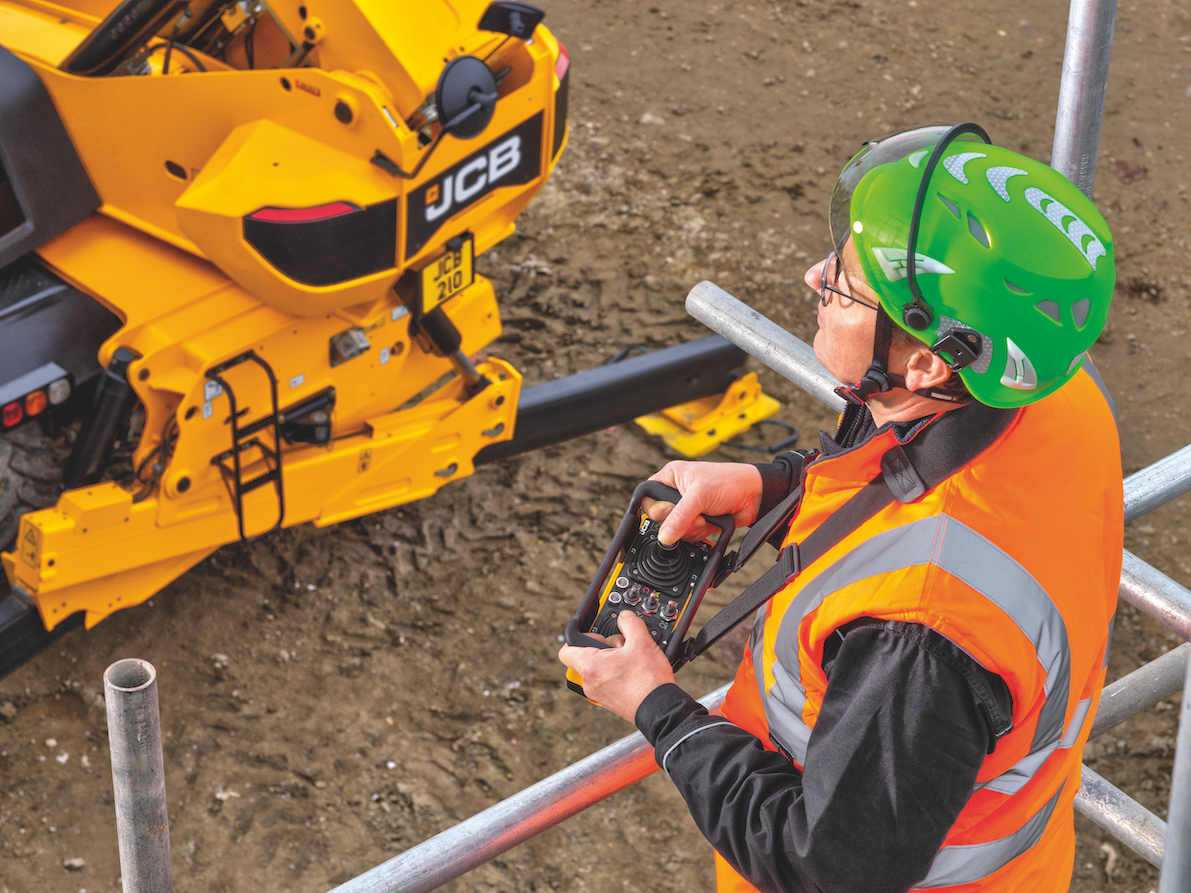
The JCB 512-83R rotating telehandler can be operated by remote control.JCBThe four-section boom with one telescopic cylinder has a low profile for better operator visibility. A camera can be mounted to its head, so the operator can see better when placing loads at height. The boom can lift up to 4,400 pounds to max height and up to 660 pounds at full horizontal reach, which is 70 feet.
The telehandler runs on a 145-horsepower JCB EcoMax diesel engine and a two-speed hydrostatic transmission. It can travel up to 25 mph and has three steering modes. Turning radius is under 10 feet. Four-wheel drive is available for off-road work.
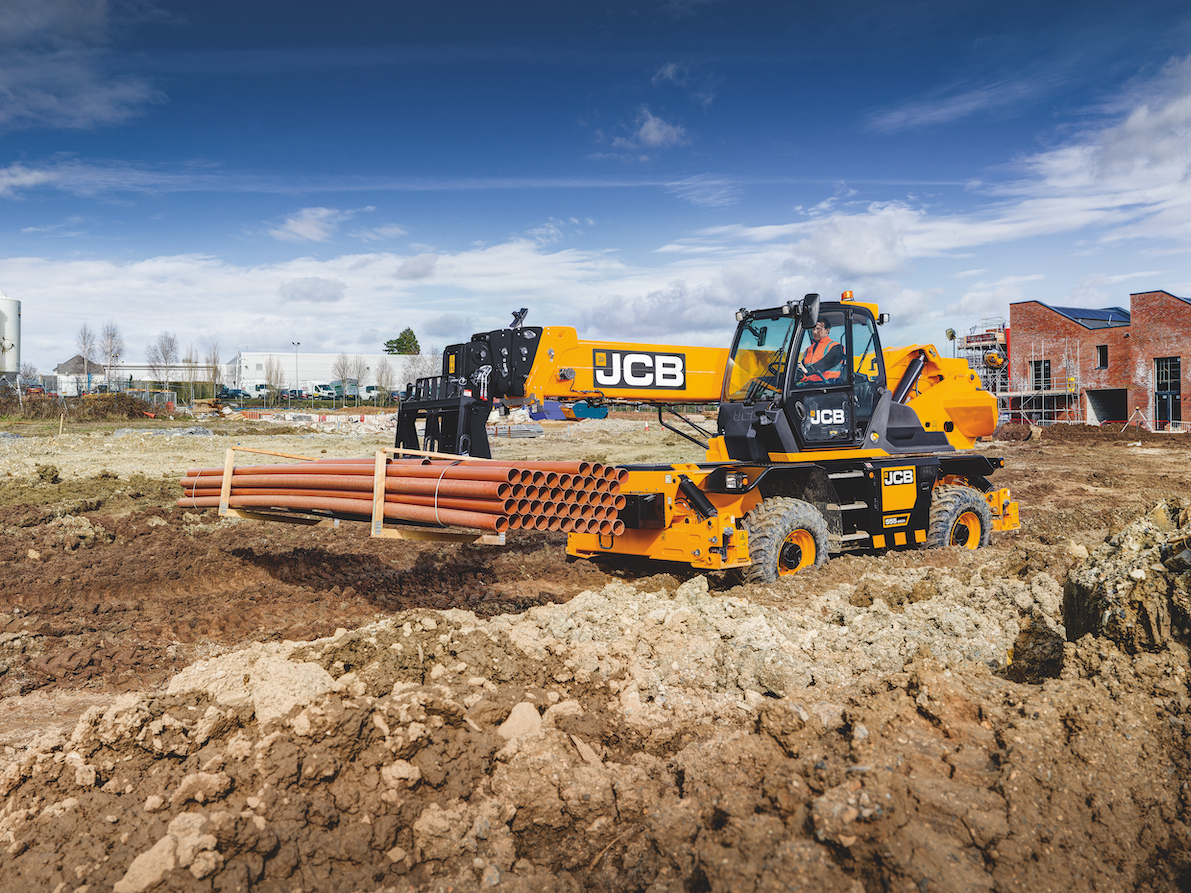
JCB 512-83R rotating telehandlerJCBThe engine and the machine’s service points have been placed at ground level for easy access. Service intervals are at 500 hours. Seating options are available for the cab. Work lights and camera kits are optional. A five-year subscription to JCB LiveLink telematics is standard.
JCB says it is currently taking orders for the 512-83R.
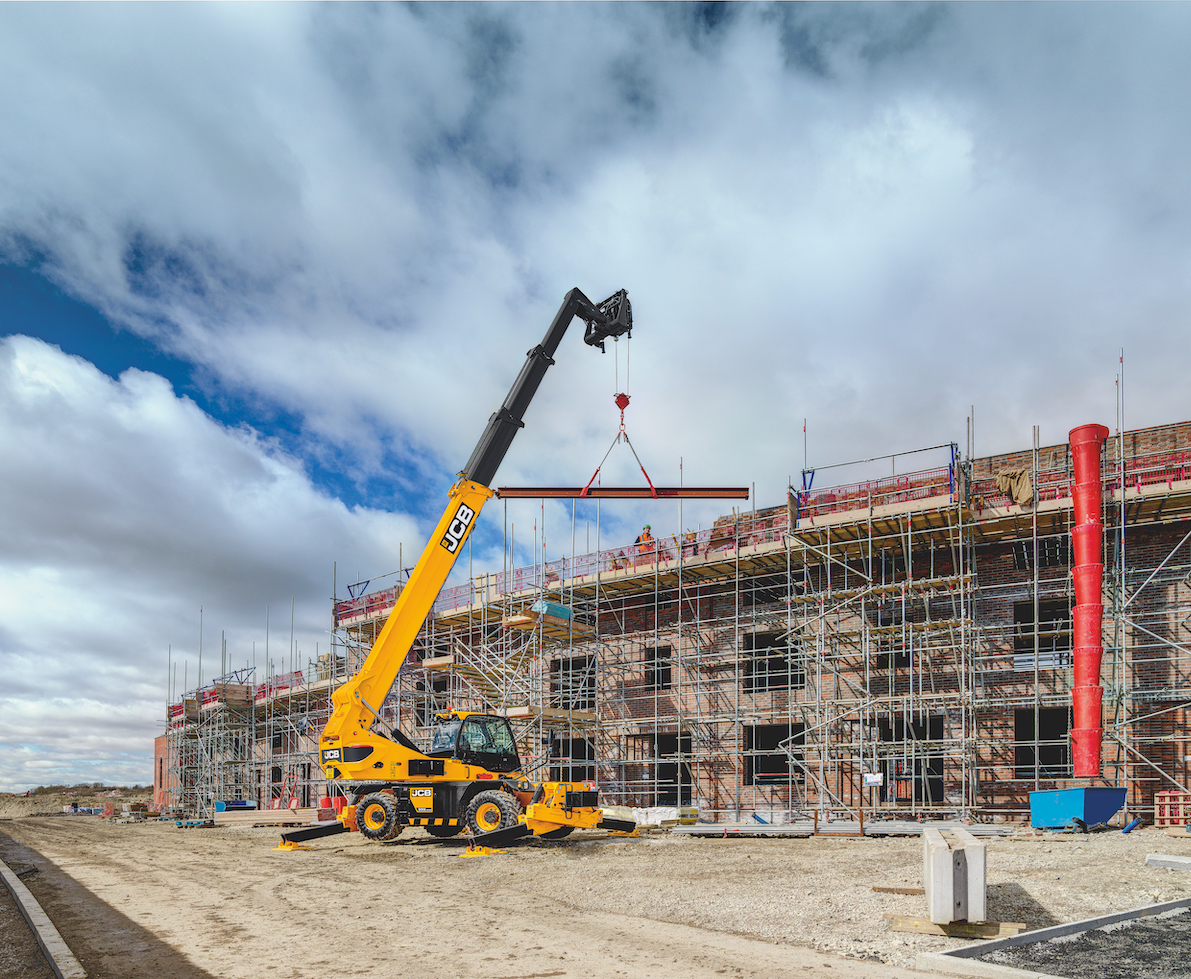
JCB 512-83R rotating telehandlerJCB
Did you miss our previous article…
https://www.tortowheaton.com/?p=494
Report: One-Fourth of Infrastructure Faces Flood Risk. (Here’s How to Check Your Area’s Threat Level.)
A new report estimates that one-fourth of all critical infrastructure in the U.S. is at risk of flooding, and that percentage will increase as storms become more severe due to climate change.
The science and technology nonprofit First Street Foundation, in what it calls “the first ever nationwide community level flood resilience report,” says state and local governments are not equipped to handle the present and future flood risks to critical infrastructure.
“As we saw following the devastation of Hurricane Ida, our nation’s infrastructure is not built to a standard that protects against the level of flood risk we face today, let alone how those risks will grow over the next 30 years as the climate changes,” says Matthew Eby, founder and executive director of First Street Foundation.
The “Infrastructure on the Brink” report says that 25% of current “critical infrastructure,” such as utilities, airports, ports, and emergency services like police, fire and hospitals, is at risk of becoming inoperable due to flooding.
It estimates these other current infrastructure flood risks:
23% of all road segments in the country (nearly 2 million miles of road). 20% of all commercial properties (919,000).17% of all “social infrastructure” facilities (72,000). This includes such properties as schools and government buildings.14% of all residential properties (12.4 million).
The risks are expected to increase through 2051.
“Over the next 30 years, due to the impacts of climate change, an additional 1.2 million residential properties, 66,000 commercial properties, 63,000 miles of roads, 6,100 pieces of social infrastructure and 2,000 pieces of critical infrastructure will also have flood risk that would render them inoperable, inaccessible or impassable,” the report says.

This chart shows the expected increase in flood risks by infrastructure category over the next 30 years.First Street Foundation’s “Infrastructure on the Brink” report
The report shows these four states facing the highest concentration of current risk: Louisiana, Florida, Kentucky and West Virginia. Of the top-20 at-risk counties in the U.S., 17 are in these four states.
The report also provides data on all at-risk cities and counties, and you can search on First Street’s website to find the flood risk for your property with the nonprofit’s free FloodFactor tool.

This chart shows the top-20 counties most at-risk to physical infrastructure flooding and the percentages of their infrastructure categories that are at risk. (Note: The “Infrastructure” column represents “critical infrastructure,” such as airports, fire stations, hospitals, police stations, ports, power stations.)First Street Foundation’s “Infrastructure on the Brink” report
For cities facing the most flood risk today, Moliere and New Orleans, Louisiana, top the rankings, with most, if not all, of their infrastructure vulnerable. Cities in California, South Carolina, Florida and Alabama also made the list.
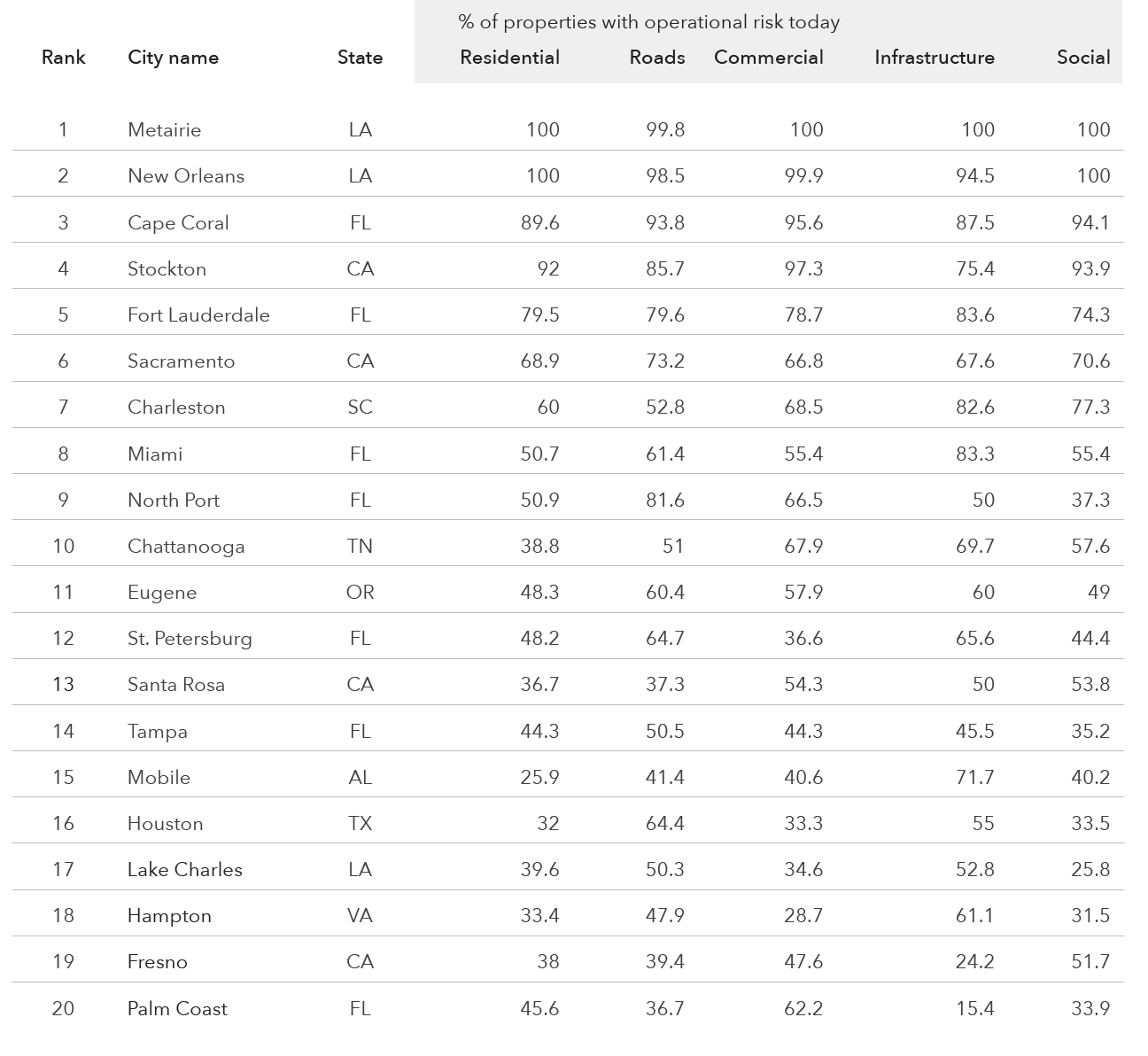
This chart shows the top-20 cities most at-risk to physical infrastructure flooding and the percentages of their infrastructure categories that are at risk. (Note: The “Infrastructure” column represents “critical infrastructure,” such as airports, fire stations, hospitals, police stations, ports, power stations.)First Street Foundation’s “Infrastructure on the Brink” report
The report also looks into the future, showing which counties will see the largest percentage increase in infrastructure risk by 2051. Virginia has several metro areas facing a significantly increased threat. The list also includes counties in North Carolina, Massachusetts, Maryland and Texas.
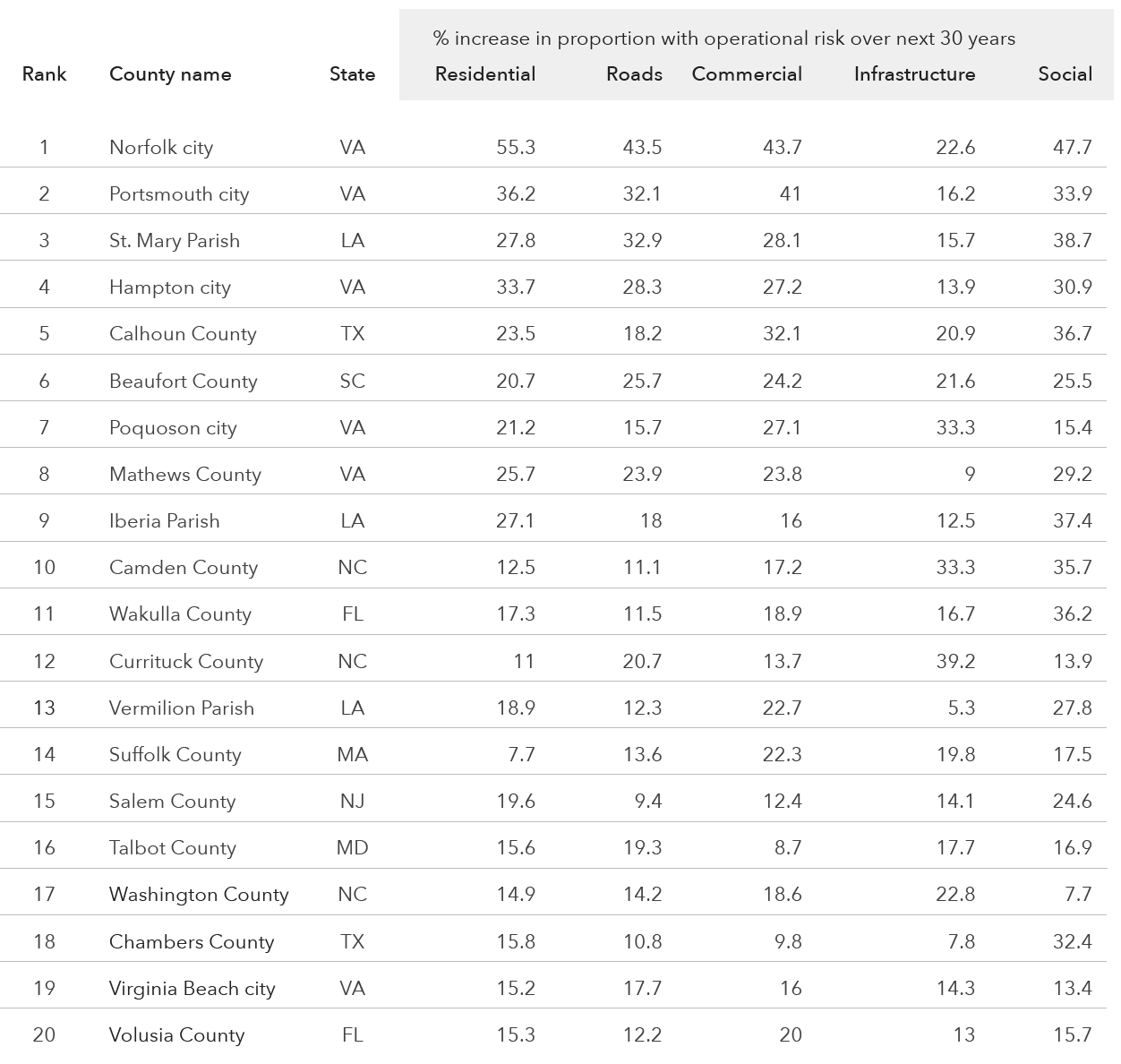
This chart shows the top-20 counties with the highest estimated percentage increase of risk to physical infrastructure flooding by 2051 and the percentages of their infrastructure categories that are at risk. (Note: The “Infrastructure” column represents “critical infrastructure,” such as airports, fire stations, hospitals, police stations, ports, power stations.)First Street Foundation’s “Infrastructure on the Brink” report
The report says the impact of the increased risks could devastate local communities. It notes that in Harris County, Texas, home to Houston, 770 hospitals, public utilities and water-treatment plants currently risk becoming inoperable due to flooding this year.
Miami-Dade, Florida, has 1,640 schools, churches and museums at risk. The Chicago metro area has 225,000 residential properties at risk. And in the New Orleans area, 99% of the roads are at risk of becoming undrivable because of flooding, the report says.
First Street Foundation hopes the data will help prioritize funding toward protecting infrastructure from flood risks.
“Our work aims to determine the amount of flooding that would render infrastructure either inoperable or inaccessible,” says Dr. Jeremy Porter of First Street Foundation. “By applying research on depth thresholds and comparing them to flood data and probability metrics, we can determine roughly the extent of flooding that would cause a road to be impassable to cars, or a hospital to be shut down.”

This map shows where the greatest flood risks are to infrastructure.First Street Foundation’s “Infrastructure on the Brink” report
Did you miss our previous article…
https://www.tortowheaton.com/?p=487